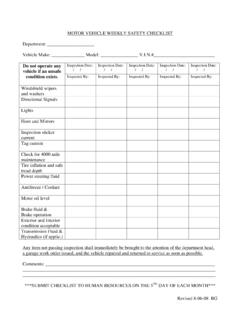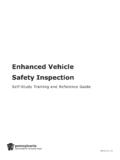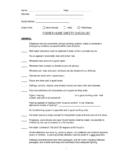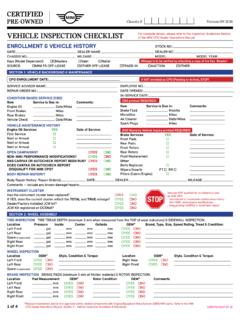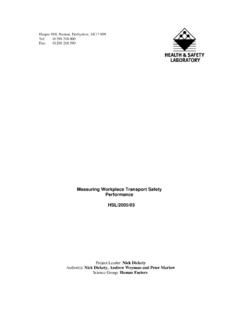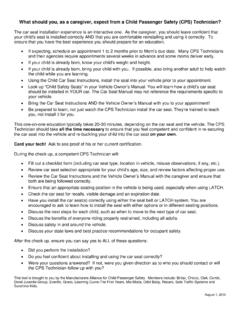Transcription of Workplace transport safety checklist HSG136
1 Health and safety Executive Site inspection: Workplace transport checklist The following checklist is a guide to what employers should consider when assessing the risk from vehicles in the Workplace . It may not be comprehensive for all work situations. Look at Find out more' if you need more information. Managing and supervising Workplace transport safety Check, in consultation with your employees, that your level of management control/supervision is adequate Are your supervisors, drivers and others, including contractors and visiting drivers, aware of the site rules and their responsibilities to help maintain a safe Workplace and environment?
2 Has a risk assessment been carried out for all Workplace transport hazards? . Is the level of supervision sufficient to ensure that safe standards are maintained? . Are penalties applied when employees, contractors etc fail to maintain these standards? . Do you take adequate steps to detect and correct any unsafe behaviour of drivers of both on-site and visiting vehicles, as well as pedestrians? . Do you make sure the underlying reasons for unsafe behaviour are investigated? . Isyourthereemployees good co-operation and liaison on health and safety matters between and those who collect or deliver goods?
3 Check what your drivers and other employees actually do when doing their work Do drivers drive with care, eg use the correct routes, drive within the speed limit and follow any other site rules? . Do you make sure your drivers and other employees have enough time to complete their work without rushing or working excessive hours? . Are your employees using safe work practices, eg when (un)coupling, . (un)loading, securing loads, or carrying out maintenance? . Do managers and supervisors set a good example, eg by obeying vehicle /. pedestrian segregation instructions, and by wearing high-visibility clothing where needed?
4 Site inspection: Workplace transport checklist Page 1 of 7. Health and safety Executive Do drivers and other employees wear any personal protective equipment provided and use any safety equipment provided? . Site layout and internal traffic routes Check that the layout of routes is appropriate Are vehicles and pedestrians kept safely apart? . Where necessary, are there suitable pedestrian crossing places on vehicle routes? . Isinstructions there a safe pedestrian route that allows visiting drivers to report for when entering the site? . Isroutes there a properly designed and signed one-way system used on vehicle within the Workplace ?
5 Are there adequate numbers of suitable and safe parking places for all vehicles and are they used? . Isactivity? . the level of lighting in each area sufficient for the pedestrian and vehicle . Check that vehicle traffic routes are suitable for the type and quantity of vehicles which use them Are they wide enough? . Do they have firm and even surfaces? . Are they free from obstructions and other hazards? . Are they well maintained? . Do . they avoid sharp or blind bends? . Check that suitable safety features are provided where appropriate Are roadways marked where necessary, eg to indicate the right of way at road junctions?
6 Are road signs, as used in the Highway Code, installed where necessary? . Are features such as fixed mirrors (to provide greater vision at blind bends), road humps (to reduce vehicle speeds), or barriers (to keep vehicles and pedestrians apart) provided where necessary? Site inspection: Workplace transport checklist Page 2 of 7. Health and safety Executive vehicle movements Check that the need for reversing is kept to a minimum and, where reversing is necessary, that it is carried out safely and in safe areas Have drive-through, one-way systems been used wherever possible to reduce the need for reversing?
7 Where reversing areas are needed, are they suitably marked or signposted to be clear to both drivers and pedestrians? . Are non-essential people excluded from areas where vehicles reverse? . Ifvehicles, there is no alternative and you have to use a banksman to direct reversing are they adequately trained and visible? Coupling/uncoupling Check that coupling and uncoupling of vehicles are carried out safely Are the tractor and trailer parking brakes always applied before the hoses are disconnected? . Do drivers check the ground will support the trailer and landing legs before uncoupling? . Are landing legs always fully extended, properly padded and locked in place as necessary?
8 Iswellthelit platform area behind the tractor unit kept clear, as clean as possible and to help prevent falls? Loading/unloading activities Check that there are safe systems for loading and unloading operations Are loading/unloading operations carried out in an area away from passing traffic, pedestrians and others not involved in the loading/unloading operation? . Are the load(s), the delivery vehicle (s) and the handling vehicle (s) compatible with each other? . Are loading/unloading activities carried out on ground that is flat, firm and free from potholes? . Are the vehicles braked and/or stabilised, as appropriate, to prevent unsafe movements during loading/unloading operations?
9 Are systems in place to prevent vehicles driving away while they are still being (un)loaded? . Are drivers and others kept in a safe place away from the vehicle during . (un)loading? Site inspection: Workplace transport checklist Page 3 of 7. Health and safety Executive Iftodrivers need to observe loading, is there a clearly marked, safe area for them do this? . Has the need for people to go onto the load area of the vehicle been eliminated where possible and, if not, is safe access provided and used? . Is appropriate lifting equipment available for (un)loading vehicles? . Isevenly loading/unloading carried out so that, as far as possible, the load is spread to avoid the vehicle or trailer becoming unstable?
10 Are checks made to ensure loads are adequately secured and arranged so that they cannot move about? . Are checks made to make sure vehicles are not loaded beyond their capacity before they leave the site? Tipping Check that tipping operations are carried out safely Do visiting drivers report to the site manager for any relevant instructions before tipping? . Are non-essential staff excluded from tipping areas? . Does tipping take place on ground that is level and stable, where there are no overhead hazards such as power lines, pipework etc? . Where sites are not level and stable, are the tipping faces safe for vehicles involved in tipping operations, eg compacted with no side slopes?










